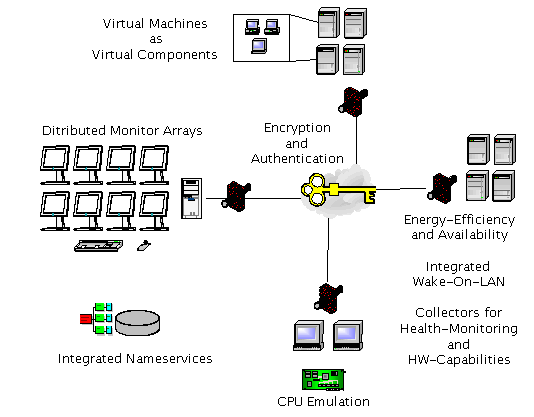Virtualization and Cloud Computing - A Summary
The UnifiedSessionsManager offers an integration framework for operations and management of local and remote sessions on physical and virtual machines.
Therefore an abstraction layer has been defined in order to provide a service oriented view to provided session types. Sesion types are defined as access to specific targets, theese could be native operating systems and control instances like hypervisors representing the administrative part of a target. As a result of this approach virtual machines are now handled through a seamless interface similar to physical machines and native host access.
The conceptual building blocks comprise elements for the establishment and management of location independent resources of interactive and server based services. These are are supported and implemented from the first version on.
Therefore a generic abstraction layer is provided which integrates various hypervisors, remote access utilities and local desktop functionality into a seamless and simplified commandline interface.
The current version supports:
- Qemu, VMware(Workstation/Server/Player), and Xen
- Linux: CentOS, Fedora, OpenSUSE, SUSE, debian, Ubuntu
- OpenBSD
- Solaris 10
- UserInterface: Shell/bash, X11, VNC(TightVNC/RealVNC), XTerm, GTerm, Emacs
- Physical Machines: Automated handling of Wake-On-LAN
- Security: SSH, sudo, ksu
Next versions are foreseen to support additionally:
- VMware(iESX), XenServer, VirtualBox, KVM
- Linux: Mandriva
- FreeBSD
- QNX, uCLinux
The main advance offered by the UnifiedSessionsManager for the current daily usage is the simplified provisioning and use of complex runtime environments. The contained tools, such as the automated scanners for the collection of present virtual machines into a spread-sheet compatible filedatabase, and the common call interface with a batch applicable shell interface, are designed for painless usage once some basics are established. Particularly the usage of huge numbers of virtual machines could be simplified by various user defined identifiers for usage as call shortcuts. This comprises for example the possibility to define groups and use them together similar to a single machine.
In addition to the management of the user sessions including the involved physical and virtual machines a user interface for the presentation is included. The Interface is based on X11 and offers an abstraction layer with logical addressing of single screens as well as monitor arrays. Specific features such as the conventional DISPLAY forwarding and a new defined CONNECTION forwarding are introduced. This allows the transparent handling of local and remote clients and the automated establishment of SSH tunnels for interconnection.
In addition to the unified user interface for the present conventional usage of virtualized environments and virtual appliances with a seamless interface, some additional future concepts are introduced and implemented. These comprise particularly the usage of nested virtual machines similar to a nested containment stack.
The virtual stacks - v-stacks - offer a containment hierarchy as the environment for the assembly of multiple VM based services into an encapsulated new service, accessible by it's virtual gateway only. The internal interface could be of any conventional network communications type, whereas the actual assembly could be handled solely by the administrator by means of conventional network administration. This offers particularly a quite adaptable approach for generic software configuration on server farms and blade clusters, but fits to a multi-core desktop perfectly as well. This is the basic facility for the introduction of virtual components - v-components - as new building blocks for virtualized network centric services.
Specific advanced features are supported as part of the implemented concept of v-stack:
- Implicit and automated boot and shutdown of underlying physical and virtual machines. This is supported for the boot of an operating system as well as for a specific contained application.
- Automated scanners, which scan local and remote filesystems for specific VMs and detect the appropriate type by specific match-filters. The results are stored into a local caching database compatible to popular spreadsheets.
- Virtaulized nameservice v-DNS, which includes v-host and v-ping. Various identifiers could be used to address a machine, including user defined labels.
The main features comprise:
- Management of distributed and stacked Virtual Machines.
- Management of Desktops and Workspaces on Multiple Monitors.
- Seamless access to all types of sessions.
- Support of encrypted connections only, based on SSH.
- Contains various tools for handling of a few up to several thousand VMs and PMs.
The provided licence is GPL3 since 02/2008.





